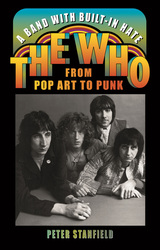
“Ours is music with built-in hatred,” said Pete Townshend. A Band with Built-In Hate pictures the Who from their inception as the Detours in the mid-sixties to the late-seventies, post-Quadrophenia. It is a story of ambition and anger, glamor and grime, viewed through the prism of pop art and the radical leveling of high and low culture that it brought about—a drama that was aggressively performed by the band. Peter Stanfield lays down a path through the British pop revolution, its attitude, and style, as it was uniquely embodied by the Who: first, under the mentorship of arch-mod Peter Meaden, as they learned their trade in the pubs and halls of suburban London; and then with Kit Lambert and Chris Stamp, two aspiring filmmakers, at the very center of things in Soho. Guided by contemporary commentators—among them, George Melly, Lawrence Alloway, and most conspicuously Nik Cohn—Stanfield describes a band driven by belligerence and delves into what happened when Townshend, Daltrey, Moon, and Entwistle moved from back-room stages to international arenas, from explosive 45s to expansive concept albums. Above all, he tells of how the Who confronted their lost youth as it was echoed in punk.
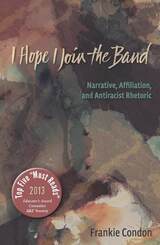
"Both from the Right and from the Left, we are stymied in talking well with one another about race and racism, by intransigent beliefs in our own goodness as well as by our conviction that such talk is useless. . . . White antiracist epistemology needs to begin not with our beliefs, but with our individual and collective awakening to that which we do not know."
Drawing on scholarship across disciplines ranging from writing and rhetoric studies to critical race theory to philosophy, I Hope I Join the Band examines the limits and the possibilities for performative engagement in antiracist activism. Focusing particularly on the challenges posed by raced-white identity to performativity, and moving between narrative and theoretical engagement, thebook names and argues for critical shifts in the understandings and rhetorical practices that attend antiracist activism.
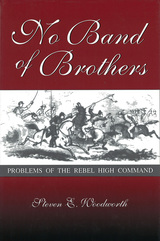
The Civil War was barely over before Southerners and other students of the war began to examine the Confederate high command in search of an explanation for the South's failure. Although years of research failed to show that the South's defeat was due to a single, overriding cause, the actions of the Southern leaders during the war were certainly among the reasons the South lost the war.
In No Band of Brothers, Steven Woodworth explores, through a series of essays, various facets of the way the Confederacy waged its unsuccessful war for secession. He examines Jefferson Davis and some of his more important generals, including Pierre G. T. Beauregard, Leonidas Polk, Joseph E. Johnston, Robert E. Lee, James Longstreet, and Thomas J. "Stonewall" Jackson; the Confederacy's strategic plans; and the South's success in making competent officers out of men with very little military preparation.
Woodworth particularly looks at the personalities and personal relationships that affected the course and outcome of the war. What made a good general? What could make an otherwise able man a failure as a general? What role did personal friendships or animosities play in the Confederacy's top command assignments and decisions? How successful was the Confederacy in making competent generals out of its civilian leaders? In what ways did Jefferson Davis succeed or fail in maximizing the chances for the success of his cause?
In analyzing the Confederate leadership, Woodworth reveals some weaknesses, many strengths, and much new information. No Band of Brothers will be an important addition to Civil War scholarship and will be welcomed by professional historians, amateur historians, students, and the general reader alike.

This is the story of the zest for life that gripped New York in the postwar years of the 1920s. The decade ushered in an era of almost unprecedented prosperity and economic expansion that made New York the powerhouse of America and fueled a wave of creativity in music, fashion, literature, and architecture. Strike Up the Band explores how the city became a magnet for a host of outstanding personalities, from literary figures to sports stars, musicians, composers, and journalists, and pays a visit to the places they frequented, such as the Cotton Club and Broadway theaters. From the skyline to the sidewalk, the city itself also transformed as it was redeveloped in the 1920s building boom, with Art Deco becoming the style that dominated the new era.
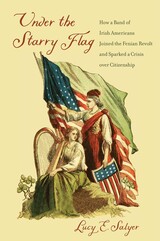
Winner of the Myrna F. Bernath Book Award
“A stunning accomplishment…As the Trump administration works to expatriate naturalized U.S. citizens, understanding the history of individual rights and state power at the heart of Under the Starry Flag could not be more important.”
—Passport
“A brilliant piece of historical writing as well as a real page-turner. Salyer seamlessly integrates analysis of big, complicated historical questions—allegiance, naturalization, citizenship, politics, diplomacy, race, and gender—into a gripping narrative.”
—Kevin Kenny, author of The American Irish
In 1867 forty Irish American freedom fighters, outfitted with guns and ammunition, sailed to Ireland to join the effort to end British rule. They were arrested for treason as soon as they landed. The Fenians, as they were called, claimed to be American citizens, but British authorities insisted that they remained British subjects. Following the Civil War, the Fenian crisis dramatized the question of whether citizenship should be considered an inalienable right.
This gripping legal saga, a prelude to today’s immigration battles, raises important questions about immigration, citizenship, and who deserves to be protected by the law.
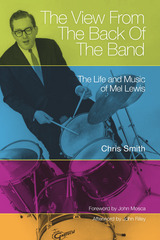
READERS
Browse our collection.
PUBLISHERS
See BiblioVault's publisher services.
STUDENT SERVICES
Files for college accessibility offices.
UChicago Accessibility Resources
home | accessibility | search | about | contact us
BiblioVault ® 2001 - 2024
The University of Chicago Press









